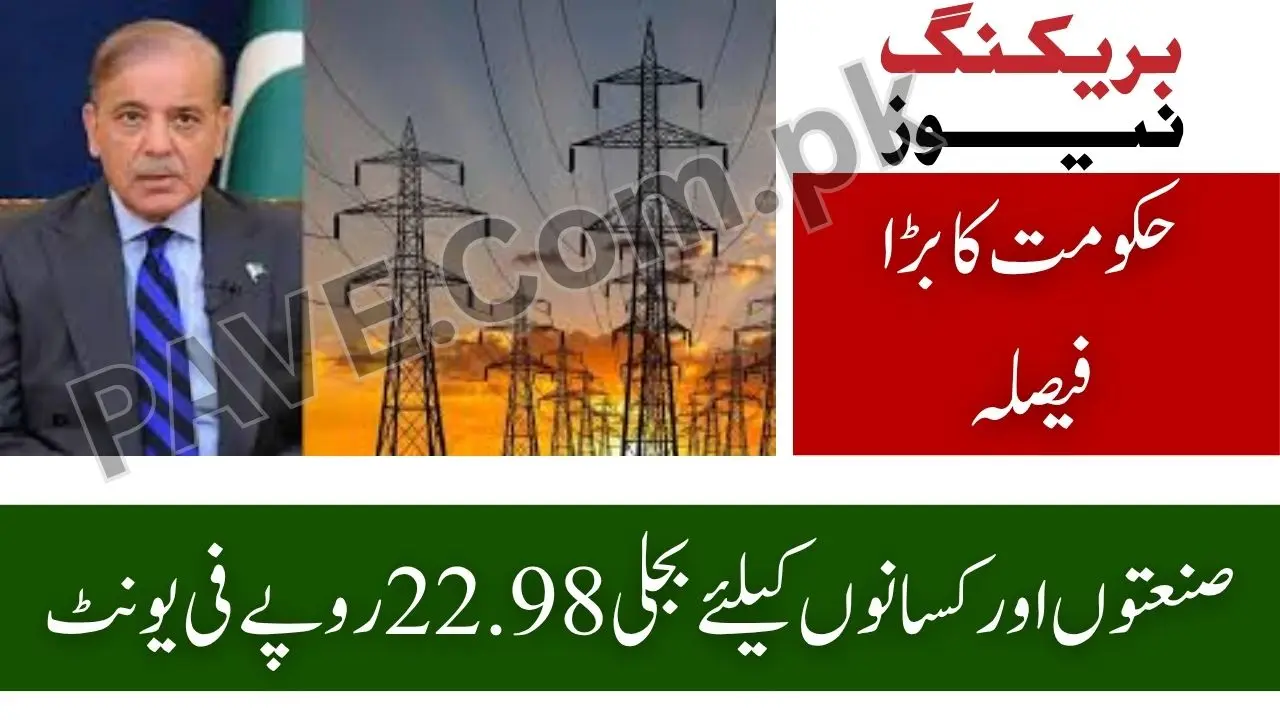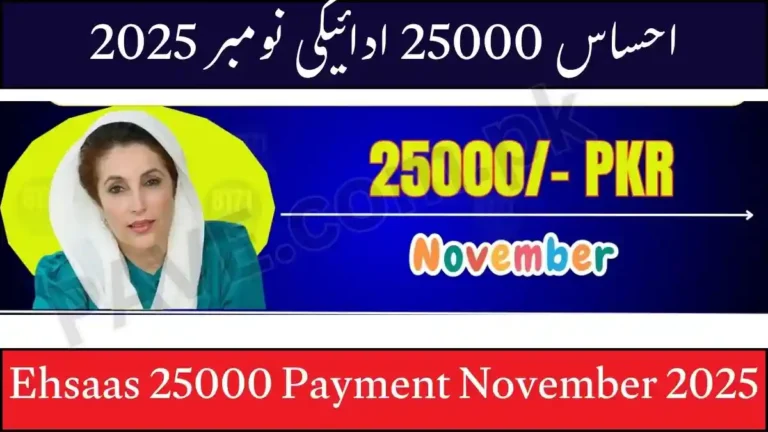Breaking News: Govt Announces Cheaper Electricity for Industrial and Agricultural Sectors for Next 3 Years
Govt Announces Cheaper Electricity for Industrial and Agricultural Sectors for Next 3 Years, marking a historic move to strengthen Pakistan’s productive economy. Prime Minister Shehbaz Sharif introduced the Roshan Maeeshat Electricity Package 2025, offering affordable electricity to factories and farmers for three consecutive years — from November 2025 to October 2028. This initiative aims to reduce power costs, promote industrial growth, and empower the agriculture sector by ensuring reliable, low-cost energy across Pakistan.
The package — running from November 2025 to October 2028 — aims to reduce production costs, encourage exports, and help farmers access affordable power for irrigation and processing.
During a high-level meeting with business community representatives and energy experts, the Prime Minister said the plan is meant to “energize” Pakistan’s economy from the ground up by supporting two key pillars: industry and agriculture.
Electricity at Rs. 22.98 per Unit – Big Relief for Productive Sectors
Under the new package, electricity will be provided to industries and farmers at a fixed concessional rate of Rs. 22.98 per unit. This represents a sharp reduction from current tariffs of Rs. 34 for industry and Rs. 38 for agriculture.
“The burden of this discounted supply will not fall on household consumers,”
said the Prime Minister, crediting Energy Minister Sardar Awais Leghari and his team for designing the initiative.
This price reduction is expected to bring down manufacturing costs, make Pakistani exports more competitive, and ease the financial pressure on farmers who rely heavily on tube-well electricity for irrigation.
Check Also: Breaking News: Punjab Govt Launches Teacher License Program
Building on Previous Success
According to official figures, a similar winter relief package last year led to the use of an additional 410 gigawatt-hours of electricity by industries and farmers. The increased consumption helped:
- Keep thousands of factories running during the slow season
- Increase production in textiles, cement, and fertilizer sectors
- Boost export volumes
- Generate tens of thousands of jobs
Building on that momentum, the new Roshan Maeeshat Package will extend these benefits nationwide and provide a stable framework for long-term planning in both sectors.
Economic Stability and Government Vision
Prime Minister Shehbaz Sharif emphasized that Pakistan’s economy has moved “from crisis to stability” through a mix of tough decisions and public support.
“We have made difficult choices and achieved results through teamwork. But our journey toward economic independence continues,”
he said, assuring that the government’s focus will remain on growth, exports, and sustainability.
He added that empowering industry and agriculture will reduce dependence on foreign loans and gradually make the country self-reliant.
Implementation Strategy and Timeline
The Ministry of Energy will soon issue detailed implementation guidelines, including:
- Eligibility criteria for industrial and agricultural consumers
- Billing adjustments under the concessional tariff
- Monitoring mechanisms to prevent misuse
- Coordination with provincial energy departments and DISCOs for rollout
The package will formally take effect from November 1, 2025, with monitoring every quarter to assess progress and benefits.
Officials say this structured approach will ensure transparency, accountability, and maximum impact.
Key Details at a Glance
| Feature | Details |
|---|---|
| Scheme Name | Roshan Maeeshat Electricity Package 2025 |
| Duration | November 2025 – October 2028 |
| Beneficiaries | Industrial & Agricultural Consumers |
| Discounted Rate | Rs. 22.98 per unit |
| Previous Rate (Industry) | Rs. 34 per unit |
| Previous Rate (Agriculture) | Rs. 38 per unit |
| Relief Margin | Rs. 11 – 15 per unit |
| Objective | Reduce production cost, increase exports, create jobs |
| Implementing Body | Ministry of Energy (Power Division) |
| Monitoring Authority | Prime Minister’s Office / Energy Task Force |
Expected Economic Impact
Experts predict that the relief will lead to:
- 15 – 20% reduction in cost for key export sectors
- Higher factory utilization rates in textiles, cement, and steel
- Affordable irrigation and mechanization for farmers
- Revival of closed industrial units
- Job creation in rural and semi-urban regions
Economists also expect the package to reduce inflation indirectly, as cheaper energy lowers input costs and helps control prices of goods.
Check Also: Breaking News: Punjab Govt Launches Maryam Nawaz Free Parwaz Card 2025
Support from Industry and Farmer Groups
Major business associations — including Aptma, FPCCI, and Chambers of Commerce — have welcomed the announcement.
They noted that high power tariffs had forced many exporters to cut production or shift operations abroad. This move, they say, will restore competitiveness and revive export growth.
Farmer unions have similarly appreciated the decision, calling it a “game changer” for the agricultural economy. Lower power costs for tube-wells and storage facilities will enable better irrigation coverage and higher crop yields.
Complementary Initiatives by the Government
The Roshan Maeeshat Electricity Package aligns with several other initiatives launched under PM Shehbaz Sharif’s economic revival agenda, including:
- PM Green Pakistan Program 2025 – providing solar-panel subsidies to reduce grid load
- Industrial Modernization Fund – supporting machinery upgrades and automation
- Kisan Card Phase 2 – enabling farmers to access credit and digital services
- Energy Efficiency Drive – introducing smart metering and renewable integration
Together, these initiatives are expected to reduce circular debt, promote clean energy, and strengthen Pakistan’s export base.
Expert Opinions and Market Reactions
Economist Dr. Hafeez Pasha praised the government’s shift from blanket subsidies toward targeted relief for productive sectors.
He stated that this approach “stimulates growth without burdening fiscal resources.”
Energy analyst Farrukh Saleem noted that offering cheaper electricity to industries during off-peak hours will balance the national demand curve and help reduce system losses.
Meanwhile, business leaders see the move as a step toward “restoring confidence in government policy” and encouraging fresh investment in manufacturing.
Long-Term Benefits for Agriculture
Pakistan’s agricultural sector consumes nearly 20% of total electricity, mainly for irrigation pumps. High tariffs had discouraged mechanized farming and pushed farmers toward expensive diesel alternatives.
The Rs. 22.98 per unit tariff will make electric tube-wells viable again, reducing fuel import dependence and greenhouse-gas emissions.
Agronomists believe this will particularly benefit Punjab and Sindh, where the majority of tube-wells operate on electric supply, helping farmers grow water-intensive crops like wheat, rice, and sugarcane more efficiently.
Sustainable Energy Future
The government is simultaneously investing in:
- Solarization of public buildings and tube-wells
- Wind projects in coastal regions
- Hydropower expansions under WAPDA
- Battery-based storage pilot projects
These renewable additions will ensure that cheaper electricity doesn’t compromise grid stability. The Power Division plans to gradually replace expensive imported fuels with clean domestic sources, aligning with the Net Zero 2050 vision.
Public Accountability and Transparency
To prevent misuse, the Energy Ministry will introduce a digital monitoring system to track how subsidized units are consumed. DISCOs will be required to submit monthly progress reports directly to the Prime Minister’s Office.
An online portal is also expected to launch, allowing businesses and farmers to register, verify eligibility, and download billing statements under the relief program.
These transparency measures will make the Roshan Maeeshat Package one of Pakistan’s most digitally monitored subsidy programs ever implemented.
Challenges Ahead
Despite optimism, experts caution that success depends on strict implementation and continuous oversight. Issues such as line losses, bill recovery, and circular debt accumulation must be managed proactively.
However, energy planners argue that higher consumption from productive sectors will actually reduce losses, since more electricity will be sold through metered and efficient channels rather than subsidized domestic lines.
Check Also: CM Punjab Free Animal Scheme 2025 Online Registration Guide
Conclusion – Govt Announces Cheaper Electricity for Industrial and Agricultural Sectors for Next 3 Years
The Roshan Maeeshat Electricity Package 2025 – 2028 reflects a turning point in Pakistan’s economic and energy policy. By offering cheaper electricity to industries and farmers, the government aims to:
- Increase exports
- Lower inflationary pressure
- Create employment
- Empower agriculture
- Build self-reliance
Implementation details from the Ministry of Energy are expected in the coming weeks, but the direction is clear — Pakistan is moving toward a sustainable, production-driven economy powered by affordable energy.







